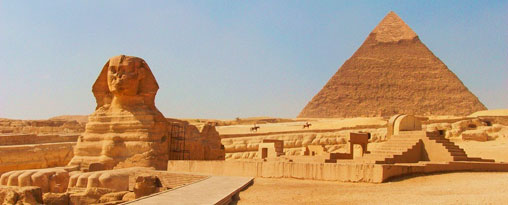
Amazing Voyages kept track of us every day and we cannot explain how important it was to us to feel that we were in very good hands. Every driver and guide was always on time and very gracious and helpful and our every need was taken care of for us. We really appreciate your professionalism.
The Plaza Grande in Quito is absolutely fabulous, the Royal Palm in the Galapagos is the best hotel we ever stayed in; the chef is outstanding, his meals are some of the best we ever had. Did you know that Prince Charles stayed there when he visited the islands? We are sure that the service we received was just as good as his. We had a marvelous time in the Galapagos and it was living a dream.
Steve and Mary. Read More
- Home
- North Africa
- Egypt Tours
- Luxury Tour 1 - Classical Egypt
Luxury Tour 1 - Classical Egypt
8 Day Luxury Tour in enchanting Egypt including 3 exotic destinations: Cairo, Alexandria and Luxor.
8 days/ 7nightsCairo - Alexandria - Luxor
Arrival to Cairo, reception and transfer to your hotel, the Four Seasons. Accommodation in a Nile view room.
Day 2: Cairo (B)
Free day at leisure. We recommend that you get accustomed to this fabulous and exotic city. Overnight at your hotel in Cairo.
Day 3: Cairo (B &D)
After breakfast, a tour of discovery of the famous Giza plateau hosting the legendary Pyramids and Sphinx. The Great Sphinx of Giza is a half-human, half-lion statue on the west bank of the Nile River. The largest monolith statue in the world, it stands 73.5 metres (241 ft) long, 6 m (20 ft) wide, and 20 m (65 ft) high. Commonly believed to have been built by ancient Egyptians in the 3rd millennium BC, it is the earliest known monumental sculpture in the world. After the tour, a visit to Memphis, the ancient capital of the first nome of Lower Egypt, and of the Old Kingdom of Egypt from its foundation until around 2200 BC. You shall also visit Sakkara, the oldest step pyramid in the world. This Ancient Egyptian necropolis consists of the Pyramid of Khufu (known as the Great Pyramid and the Pyramid of Cheops), the somewhat smaller Pyramid of Khafre (or Chephren) a few hundred metres to the south-west, and the relatively modest-size Pyramid of Menkaure (or Mykerinus) a few hundred metres further south-west, along with a number of smaller satellite edifices, known as "queens" pyramids, causeways and valley pyramids. The Great Sphinx lies on the east side of the complex, facing east. Current consensus among Egyptologists is that the head of the Great Sphinx is that of Khafre. Associated with these royal monuments are the tombs of high officials and much later burials and monuments (from the New Kingdom onwards), signifying the reverence to those buried in the necropolis.
Of the five, only Menkaure's Pyramid is seen today without any of its original polished limestone casing, with Khafre's Pyramid retaining a prominent display of casing stones at its apex, while Khufu's Pyramid maintains a more limited collection at its base. Khafre's Pyramid appears larger than the adjacent Khufu Pyramid by virtue of its more elevated location, and the steeper angle of inclination of its construction - it is, in fact, smaller in both height and volume. The most active phase of construction here was in the 25th century BC. It was popularised in Hellenistic times when the Great Pyramid was listed by Antipater of Sidon as one of the Seven Wonders of the World. Today it is the only one of the ancient Wonders still in existence. The step pyramid at Sakkara was designed by Imhotep for King Djoser (c.2667-2648 BC). It is the oldest complete hewn-stone building complex known in history Dahshur, Abu Ruwaysh, and Abusir, were collectively declared a World Heritage Site in 1979.
Transfer back to your hotel. Dinner at your hotel.
Day 4: Cairo - Alexandria (B & D)
Early breakfast, a private drive to Alexandria some 220 Km, approximately 3 hours a way. In ancient times, Alexandria was one of the most famous cities in the world. It was founded around a small pharaonic town c. 331 BC by the Greek Macedonian king Alexander the Great. It remained Egypt's capital for nearly a thousand years, until the Muslim conquest of Egypt in 641 AD when a new capital was founded at Fustat, later absorbed into Cairo.
Alexandria was known for the Lighthouse of Alexandria (one of the Seven Wonders of the Ancient World), whose remains lie on the floor of Alexandria's Eastern Harbour; the Library of Alexandria (the largest library in the ancient world) and the Catacombs of Kom el Shoqafa (one of the Seven Wonders of the Middle Ages). Ongoing maritime archaeology in the harbour of Alexandria, which began in 1994, is revealing details of Alexandria both before the arrival of Alexander, when a city named Rhakotis existed there, and during the Ptolemaic dynasty.
Upon arrival you shall visit the catacombs, Pomp's Pillar, Kom El Shokafa, Montazah Garden & Panoramic view of Qait Bay Fortress. Return to Cairo. Tonight you shall enjoy a Nile River cruise and dinner with an oriental show.
Transfer back to your hotel. Overnight at your hotel in Cairo.
Day 5: Cairo (B & L)
After breakfast, a private visit to the famous Egyptian museum, to see the tomb of King Tutankhamun which was found mostly intact. Inside the tomb you will find a large collection of artifacts used throughout the King's life. Visit to the Salah El Din Citadel, Alabaster Mosque, Old Cairo (Old Coptic Church "El Moallaka" Hanging Church then your tour will continue to the Old Synagogue of Ben Ezra, the Abu Sirgha Church, Al Hussein Mosque all in old Cairo area.
Proceed to visit Khan El Khalili bazaars, the old markets which date back to 1382.
Lunch at "Le Pasha 1901 boat" over looking to the Nile. Transfer back to your hotel. Overnight at your hotel in Cairo.
Day 6: Cairo - Luxor (B)
After breakfast, check-out from the hotel and transfer to Cairo airport for the domestic flight to Luxor. Upon arrival to Luxor airport, reception and transfer to the Sofitel Old Winter Palace . Accommodation in a"Deluxe Room - Nile View.
Afternoon, you will start visits ofthe East Bank of Luxor where you will enjoy exploring the complexes of Karnak and Luxor temples with your guide. Transfer back to your hotel. Overnight at your hotel in Luxor.
Day 7: Luxor - Valley of the Kings (B)
After breakfast at your hotel, leave for the West Bank of Luxor where you will see the huge Colossi's of Memnon. The Colossi of Memnon (known to locals as el-Colossat, or es-Salamat) are two massive stone statues of Pharaoh Amenhotep III. For the past 3400 years they have stood in the Theban necropolis, across the River Nile from the modern city of Luxor. The statues are made from blocks of quartzite sandstone which was stone quarried at either el-Gabal el-Ahmar (near modern-day Cairo) and near Edfu (north of Aswan) when reconstructed. Including the stone platforms on which they stand, they reach a towering 18 metres (approx. 60 ft) in height.
A visit to the temple of Queen Hatshepsut and the 3 tombs in the Valley of the Kings & Valley of the Queens. The valley of the kings is a valley in Egypt where for a period of nearly 500 years from the 16th to 11th century BC, tombs were constructed for the kings and powerful nobles of the New Kingdom (the Eighteenth through Twentieth Dynasties of Ancient Egypt). The valley stands on the west bank of the Nile, across from Thebes (modern Luxor), within the heart of the Theban Necropolis. The wadi consists of two valleys, East Valley (where the majority of the royal tombs were situated) and the West Valley The area has been a focus of concentrated archaeological and Egyptological exploration since the end of the eighteenth century, and its tombs and burials continue to stimulate research and interest. In modern times the valley has become famous for the discovery of the tomb of Tutankhamun (with its rumours of the Curse of the Pharaohs]), and is one of the most famous archaeological sites in the world. In 1979, it became a World Heritage Site, along with the rest of the Theban Necropolis. Transfer back to your hotel.
Overnight at hotel in Luxor.
Day 8: Luxor - Cairo (B)
Check-out from your hotel and transfer to Luxor airport for the domestic flight to Cairo and your connecting flight home.
Day 2: Cairo (B)
Day 3: Cairo (B &D)
Day 4: Cairo - Alexandria (B & D)
Day 5: Cairo (B & L)
Day 6: Cairo - Luxor (B)
Day 7: Luxor - Valley of the Kings (B)
Day 8: Luxor - Cairo (B)
- Accommodation at the 5* Four Seasons Hotel in Cairo (Nile-view room) on a bed & breakfast basis and 2 night's.
- Accommodation at the 5* Winter Palace Hotel in Luxor (Nile-view room) on a bed & breakfast basis.
- All transfers in Cairo as per itinerary in a private air conditioned executive car and a private air conditioned vehicle in Luxor.
- Full day visit to the Pyramids, Sphinx, Memphis & Sakkara including transportation, entrance fees & qualified English speaking guide.
- Over day Alexandria visit to the catacombs, Pomp's Pillar, Kom El Shokafa, Montazah Garden & Panoramic view of Qait Bay
- Fortress from the outside including transportation, entrance fees & qualified English speaking guide.
- Full day visit to the Egyptian Museum, Salah El Din Citadel, Alabaster Mosque, Old Cairo (Old Coptic Church El "Moallaka" Hanging Church, the Old Synagogue of Ben Ezra, the Abu Sirgha Church, Al Hussein Mosque including lunch at Le Pasha 1901 boat, with transportation, entrance fees & qualified English speaking guide.
- Full day Luxor visit to the East Bank (Karnak Temple & Luxor Temple) including transportation, entrance fees & qualified English speaking guide.
- Full day Luxor visit the West Bank (Hatshepsut Temple, Colossi of Memnon, Valley of the Queens & Valley of the Kings) including transportation, entrance fees & qualified English speaking guide.
- Nile Cruise dinner with oriental show.
- Local Assistance by our representatives throughout the trip.
- Private transfers, tours & English speaking Egyptology.
- Domestic air flight tickets (Cairo - Luxor / Luxor - Cairo) in business class subject to change & availability.
- International flight to Egypt.
- Entry Visa of Egypt (Cost USD 20.00 per person)
- Any expenses of a personal nature (telephones, laundry, tips, etc).
- Entrance inside the Great Pyramids & the Solar Boat in the Pyramids area.
- Entrance inside the Mummies room at the Egyptian Museum.
- Gratuities & Tips.
- All beverages during meals.
- Any services not mentioned.
Worldwide: + 44 (0) 20 33938062 / USA & Canada Toll free: 1800-894-8003 - UK Freephone +44 (0) 20 33938062
Peru Office: Av. Benavides 2406, Miraflores, Lima.
UK Office: 52 Brook Street, Mayfair, London W1K 5DS
© 2000-2025 Amazing Voyages Ltd. All rights reserved. | Terms & Conditions | Site Map













